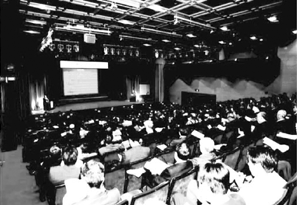
Scene of a special lecture
 Scene of a special lecture |
1. "Railways as an eco-service," Ryoichi YAMAMOTO, Doctor of Engineering, Professor, Tokyo University
In the 21st century, people seek products, services, management, infrastructures and social systems that pay thorough attention to the global environment. It is now urgently required to develop products and services, in particular, that will maximize the environment efficiency, or the quotient obtained by dividing the performance or the added economic value of a product by the environmental load over its life cycle. Railways, which feature extremely lower CO2 emission than that of other transport facilities, are an excellent transport mode in terms of the environment efficiency. In this regard, Professor Yamamoto emphasized the necessity to raise the environment efficiency of railways further in the development of rolling stock, improvement of infrastructures and implementation of transport services.
2. "Sustainable transport systems and city structures in urban areas," Masatsugu MURABAYASHI, General Manager, Strategic Urban/Regional Research and Planning, Value Management Institute, Inc.
Mr. Murabayashi adopted a transport and land utilization model and verified its validity by analyzing the effect on the CO2 emission of the improved major transport infrastructures and core cities developed in the Metropolitan area by 2020.
3. "Application of LCA to railways," Taro TSUJIMURA, Doctor of Engineering, Senior Researcher, Laboratory Head, Tribology, Materials Technology Division, RTRI
Dr. Tsujimura used the technique of life cycle assessment (LCA) to compare CO2 emissions from various transport facilities, and introduced the application of LCA and future subjects for railways.
4. "Comparison of railways with other transport facilities," Kazuo SAWADA, Senior General Manager of Technology, Maglev Systems Development Department, RTRI
Mr. Sawada introduced the energy consumption and CO2 emission per transport unit separately for passenger and transport services to verify that railways were an excellent transport mode for the global environment, and the maglev system was superior to airlines in short-and medium-distance services in terms of the energy consumption and CO2 emission.
5. "Further pursuance of energy saving and clean energy," Hiroshi HATA, Senior Researcher, Laboratory Head, Traction Control, Vehicle Control Technology Division, RTRI
Mr. Hata reported the latest research results and developments now being promoted at RTRI, such as the development of power storage and recycled rolling stock to save energy and fuel cell railway vehicles to use clean energy.
6. "Application of material recycling to railways," Katsuyoshi UEYAMA, Senior Researcher, General Manager, Materials Technology Division, RTRI
Mr. Ueyama introduced the technologies to recycle materials used in railways, soil excavated at construction sites and waste materials generated on railway vehicles, to reuse for railways.
7. "Efforts of railways for environment preservation," Yukinori KOYAMA, Doctor of Engineering, General Manager, Planning Division, RTRI
Dr. Koyama briefly explained the efforts of railway promoters in Japan to improve the efficiency of railway systems, promote energy saving and introduce clean energy, and outlined the concept of external costs as a means to evaluate transport facilities.